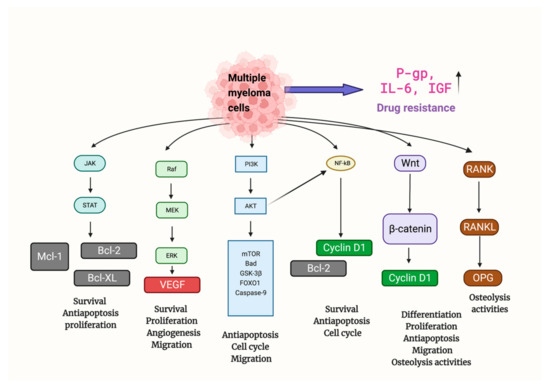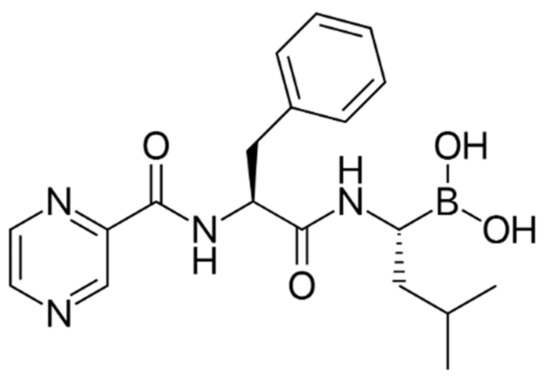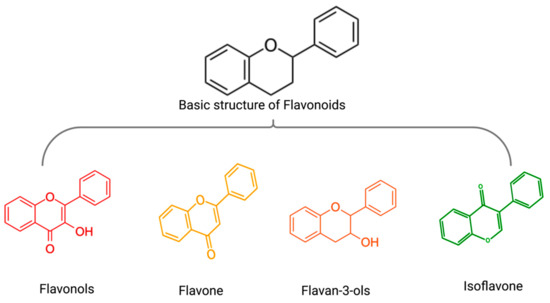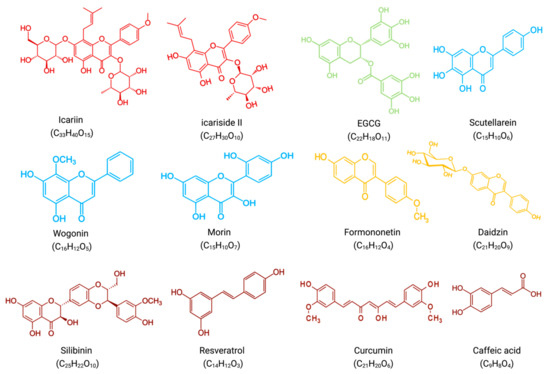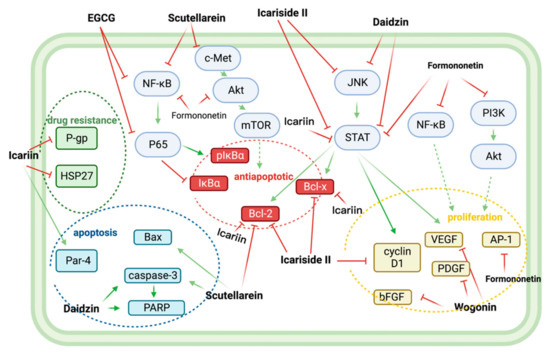Figure 56. Nine flavonoids, icariin, icariside II, EGCG, scutellarein, wogonin, morin, formononetin, daidzin, and isoginkgetin, together exerted multiple synergistic BTZ anti-MM effects. Icariin synergistically improved the drug sensitivity of MM to BTZ by reducing the expression of drug resistance proteins HSP27 and P-gp. EGCG, scutellarein, icariin, icariside II, and formononetin down-regulated the downstream anti-apoptotic proteins Bcl2, BclXl, pIκBα by inhibiting NF-κB, c-Met/Akt/mTOR, and JAK/STAT pathways, thereby synergistically reversing anti-apoptosis. Icariside II, formononetin, and Wogonin, with BTZ synergistically, exerted antiproliferative effects by downregulating VEGF, PDGF, bFGF, cyclin D1, and AP-1. Finally, scutellarein, Daidzin, and Icariin enhanced BTZ-related apoptosis by upregulating the expression of Par-4, Bax, caspase-3, and PARP. Abbreviations: AP-1: Activator protein 1; Bax: bcl-2-like protein 4; Bcl2: B-cell lymphoma 2; Bcl-xl: B-cell lymphoma-extra-large; bFGF: basic fibroblast growth factor; c-Met: tyrosine-protein kinase Met; NF-κB/P56: Nuclear factor-kappa-B/p65; HSP27: Heat shock protein 27; JAK/STAT: Janus kinases/signal transducer and activator of transcription proteins; IκBα: nuclear factor of kappa light polypeptide gene enhancer in B-cells inhibitor, alpha; TOR: mammalian target of rapamycin; PARP: Poly (ADP-ribose) polymerase; Par-4: Prostate apoptosis response-4; PDGF: Platelet-derived growth factor; P-gp: P-glycoprotein; PI3K/Akt: Phosphoinositide 3-kinases/Protein Kinase B.
In KM3/BTZ-resistant cells, icariin increased the sensitivity of KM3/BTZ cells to BTZ and partially reversed the drug resistance. Its effect on changing drug resistance may be mediated by upregulating the expression of pro-apoptotic cytokine Par-4, decreasing the expression of drug resistance proteins HSP27 and P-gp
[11][22]. Another study found that the combination of icariin and BTZ promoted apoptosis in U266 cells by blocking the JAK/STAT pathway and lowering the expression of anti-apoptotic proteins like Bcl-2, Bcl-xl, and Survivin. This combination also delayed the cell cycle progression, as shown by the result that more U266 cells were in the G0/G1 phase
[12][23].
While icariside II enhanced the apoptotic effect of BTZ in U266 cells, it also inhibited the JAK/STAT pathway and down-regulated the expression of STAT3 target genes Bcl-2, Bcl-xl, Survivin, cyclin D1, COX-2, and VEGF, beneficially inhibiting proliferation and promoting apoptosis
[13][35].
EGCG, a catechin in green tea, and BTZ synergistically inhibited KM3 cell growth and induced apoptosis by inhibiting NF-κB/P65 expression, down-regulating pIκBα, and up-regulating IκBα expression
[14][36].
In vitro, scutellarein alone time-dependently reduced cell viability and significantly induced apoptosis in MM.1R and IM-9 cells. In vivo, dual intervention with scutellarein and BTZ significantly reduced xenograft tumor burden in nude mice with no significant effect on mouse body weight. In parallel, protein expression levels of some apoptotic markers were altered, such as active caspase-3 (upregulated), Bax (upregulated), and Bcl-2 (downregulated)
[15][25].
Wogonin and BTZ synergistically inhibited the secretion levels of pro-angiogenic factors VEGF, PDGF, and bFGF in RPMI 8226 cells. The angiogenesis-inhibitory effect of wogonin may be related to its inhibition of the c-Myc/HIF-1α signaling axis
[16][26].
Morin potentiates BTZ-induced apoptosis in U266 cells, from 18.7% to 51.2%, by inhibiting the STAT3 pathway, leading to downregulation of STAT3-dependent gene expressions, such as XIAP, cFLIP, Mcl-1, Survivin, Bcl2, BclXl, and c-IAP-2. And morin’s inhibition of STAT3 phosphorylation was more pronounced than other flavonols (galangin, kaempferol, quercetin, and myricetin) with different positions and numbers of its hydroxyl groups on the B-loop
[17][27].
In vitro, formononetin and BTZ enhanced STAT3 inhibition and promoted the death of U266 cells
[18][28]. Subsequently, a follow-up study by the same research group found that formononetin and BTZ exert synergistic enhancement of anti-proliferation and pro-apoptosis by blocking the activation of NF-κB, PI3K/AKT, and AP-1
[19][29].
Daidzin synergistically increased the apoptotic and cytotoxic effects of BTZ by inhibiting the activation of STAT3 and its upstream kinases (JAK1, JAK2, and c-Src). In addition, this drug combination increased caspase-3 activation and PARP cleavage, leading to the downregulation of the expression of various oncogenic apoptotic proteins
[20][30].
In vitro, PGJ inhibited angiogenesis, microvascular growth outside of aortic rings, cell migration, and invasion in MM cells. In addition, After BTZ exposure, PGJ intervention increased the cytotoxic effects on U266 cells
[21][31].
5. Synergistic Effects of Non-Flavonoid Polyphenols and Bortezomib in Anti-MM
In combination with low concentrations of BTZ, silibinin increased the cytotoxic effect of BTZ by increasing the expression of activated caspases, which promoted apoptosis [22][32].
In vitro, resveratrol induced apoptosis in MM144 cells by upregulating the Fas/CD95 signaling pathway and caspase-8 and caspase-10. Moreover, when used in combination, resveratrol, and BTZ highly enhanced U266 cell apoptosis [23][37].
Curcumin enhances the apoptotic effect of BTZ on MM cells by regulating multiple signaling pathways. The bone marrow microenvironment, in which bone marrow stromal cells (BMSCs) interact with MM, influences the survival and growth of MM cells. In vitro, curcumin inhibited the activation of JAK/STAT and MAPK pathways in U266 cells after treatment with BMSCs cell supernatant. Additionally, curcumin and BTZ co-treatment efficiently prevented IL-6-induced STAT3 and Erk phosphorylation, increased PARP cleavage, and decreased pro-caspase-3 levels. Through these mechanisms mentioned above, this combination inhibited the growth of U266 cells and promoted apoptosis [24][38].
In vitro, caffeic acid alone inhibits NF-κB-binding activity and IL-6 levels, which are closely linked to apoptosis and growth of tumor cells. Moreover, the combination of caffeic acid and BTZ synergistically increased cytotoxic and anti-proliferative effects on ARH-77 cells
[25][34].
